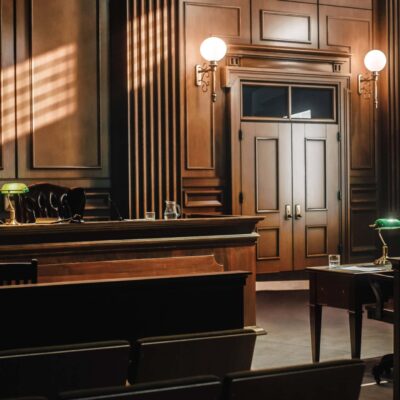Last month, WIT Director Jeremy Scholem joined a panel for Managing IP’s Intellectual Property and Innovation Summit to discuss key developments in US IP and trademark litigation, covering US legislative efforts, the Federal Circuit, ITC filings, and NPE litigation. The panel featured an array of esteemed professionals including Brian Matty, Partner, Desmarais; Matthew Bathon, Principal Legal Counsel II, Legal Management, Samsung Electronics; Monisha Deka, Investigative Attorney, Office of Unfair Import Investigations, US International Trade; Blair Jacobs, Principal, McKool Smith; and Ali Razai, Partner, Knobbe Martens.
The event brought together more than 200 senior IP professionals from across a wide range of industries to discuss how the IP landscape is evolving.
Let’s look back at some of the key talking points from the panel discussion and evaluate what they mean for the future of the intellectual property and trademark litigation landscape.
An Update on Federal Circuit Cases and Section 101
Recently, there have been some interesting decisions on obviousness and nuanced issues at the PTAB. When considering developments coming out of the Federal Circuit for IPR cases, one notable case involved the PTAB issuing sanctions against Longhorn Vaccines and Diagnostics for withholding information during an IPR of five patents. This has been called an “unprecedented move” made by the PTAB, with Knobbe Martens stating that this “marks the first time since Congress enacted the IPR process that the PTAB has canceled all claims of a patent based on the patent owner’s ‘unwarranted disregard relating to its duty of disclosure and fair dealing before [the PTAB].’”
The PTAB’s perspective on discovery and disclosure requirements remains an open question as we wait for the results of Director Vidal’s sua sponte review of the Longhorn decision. Specifically, those in the space are looking for the possibility of compensatory attorneys’ fees, reversal of the adverse judgment, or some additional statement indicating her desired outcome in future cases. The issue of the applicability of work product protection to scientific data also awaits her comment. Regardless of the specifics of the Longhorn review, it has become clear that the USPTO remains serious about enforcing PTAB discovery rules and monitoring what they have determined is “bad behavior.”
In keeping a close eye on appeals and development at the Federal Circuit, there has been a plethora of Section 101 cases getting attention. Recently, 101 proceedings have been highly dependent on panels, which is hugely important because lack of predictability often discourages settlement. Generally, you can find opinions that go both ways on most eligibility questions, but the key seems to remain with written support for innovation or improvement in the intrinsic record as a whole. In the current environment, your case may simply be decided by which judge hears it as they all possess different opinions on Section 101 analyses.
An Overview of Recent ITC Filings
Given that our panel members had extensive experience working with the International Trade Commission (ITC), they had some insights to share on recent proceedings at the venue as well as what the future may hold for legal activity in the space. When looking at ITC filings for the past two years, 2023 has seen a dip in cases that are starting to turn heads. In fact, filings have decreased by 25%, and it is suspected that tougher industry requirements and increased activism from the Commission, among other things, are prompting the shift.
In the past, spikes in ITC filings could be attributed to the tech bubble and further, the proliferation of smartphone technology. But that was a decade ago and today, the Commission has yet to see the “next big thing” to drive activity at the venue. Our panel considered this and remarked that this “next big” catalyst for filings may not be coming any time in the immediate future. While there is a lot of activity in the artificial intelligence space, AI technology and its relevant patents are not likely to lend themselves to many ITC cases. This decrease in ITC filings could also be a part of a greater dip in patent and tralitigation generally; filings in the district court and PTAB are also down this year on account of COVID-19 effects and fatigue, but still not to the same degree as the ITC.
Recent NPE Litigation
In addition, NPE litigation seems to have declined in the past year, by some measures down almost 34% Q1-Q3 YOY. Many lawyers have pointed to the change in judge assignment rules in the Western District of Texas as a cause, though the absence of IPEdge filings plays an outsized role as well. AIA reviews have also dipped in the same period, dropping to a new quarterly low in Q3 of this year at 264.
Understanding the Impact of US Legislative Efforts RE: FRE 702
When evaluating recent legislative efforts, it would be remiss to ignore the upcoming amendments to Federal Rule of Evidence 702- the rule that governs the admission of expert testimony. The amendment does not go into effect until December 1, 2023, and will largely impact pre-trial strategy going forward. The change aims to clarify the standard for admissibility of an expert’s testimony. The new language in the Rule eliminates the opportunity for improper application by emphasizing that:
- “Expert testimony may not be admitted unless the proponent demonstrates to the court that it is more likely than not that the proffered testimony meets the admissibility requirements set forth in the rule.”
- “Each expert opinion must stay within the bounds of what can be concluded from a reliable application of the expert’s basis and methodology. Judicial gatekeeping is essential because just as jurors may be unable, due to lack of specialized knowledge, to evaluate meaningfully the reliability of scientific and other methods underlying expert opinion, jurors may also lack the specialized knowledge to determine whether the conclusions of an expert go beyond what the expert’s basis and methodology may reliably support.”
While the rule changes are not dramatic, many of the proponents supported the changes to address what they felt was a bias towards admissibility in the Federal courts. The changes bring into focus the need to carefully select an expert and the potential liability of using an expert that has a background that has less than ideal connections to the subject matter.
As told by Scholem: “While the amendment has been couched as a mere clarification, the clarification was put into place because many courts were interpreting the old rule to require a lower standard. Further, the more explicit language about how to test an expert’s admissibility is likely to encourage all courts to weigh the question more carefully. “
Looking to the PTAB’s sentiment for Rule 702, the entity generally seems reluctant to wholly exclude experts because they are specialized judges and can determine what power to give expert testimony. But the rule changes might have a big effect in district court. One of the problems with any rule change is always predicting implementation. Imagine if an expert is the subject of a motion under the new rule – such a motion may be more likely to be successful and may be granted at a date that creates significant issues.
Experts in IP and Trademark Litigation
With regards to Rule 702, attorneys should pay close attention to the quality of experts they retain and put their trust in an expert witness company with highly credentialed academics, industry insiders, and legal professionals who know the challenges of IP and trademark litigation along with what it takes to be a successful expert witness. After all, now more than ever, an expert’s reputation, expertise, education, and experience can have a significant impact on the outcome of a case.
To learn more about the impact of Rule 702 and best practices in retaining qualified experts, contact us to discuss your expert witness needs. Follow us on LinkedIn and Twitter to stay up-to-date on our latest insights.




